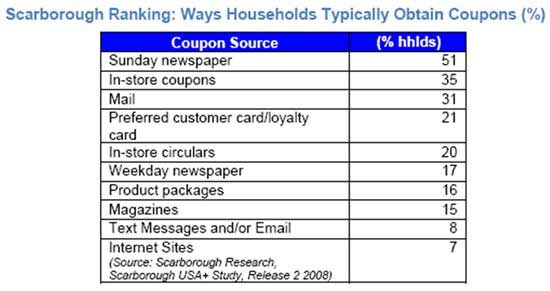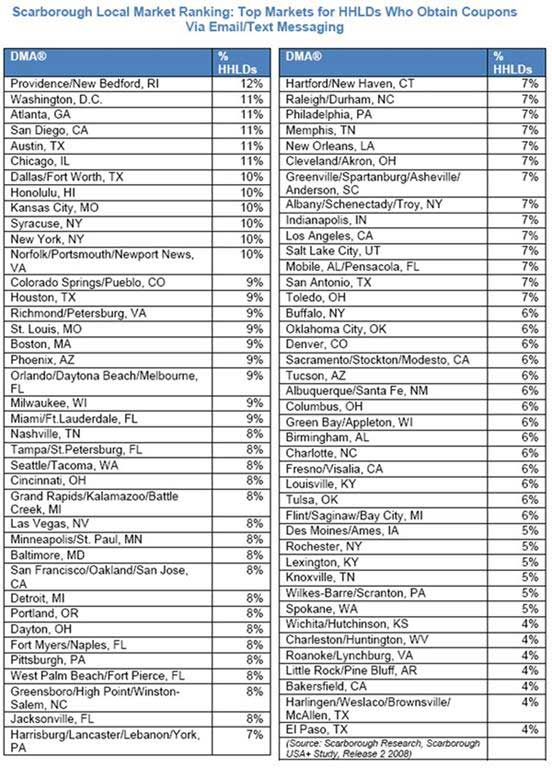US consumers are increasingly using e-coupons, as well as their traditional print cousins, as a way to trim spending as the recession drags on, according to new research from Scarborough Research (August 2009) and recent research from Burst Media (March 2009).
A significant benefit e-coupons hold over traditional print coupons is that they are more targeted to the consumer. "Coupons received via text messaging are typically sent only to consumers who have opted in to receive them. This increases the relevancy of the offer and the potential for the consumer to act on that offer," says Gary Meo, senior vice president of digital media and print services at Scarborough Research. "An additional benefit is the mobility of cell phones and other personal communications devices, which allow consumers to access the coupon at the point of purchase."
Some 8.6 million households in the US—about 8% of all US households—regularly use e-coupons, Scarborough Research found, although the Sunday newspaper remains the most popular coupon source:

E-Coupon Users: Who They Are and Where They Live
Consumers who obtain coupons via text messages and/or email tend to be young, affluent, educated, and female, according to Scarborough. The company's research found that they are:
- 14% more likely than the average adult to be ages 18-24.
- 51% more likely to be a college graduate or have an advanced degree.
- 6% more likely to be female.
The top local market for text message and/or email coupon users is Providence, RI—one or more members of 12% of households in Providence typically obtain coupons via text message or email. Some 11% of households in Washington, DC, Atlanta, San Diego, Austin, and Chicago obtain coupons via email/text message. Usage in other cities, according to Scarborough:

Burst Media's Findings
Burst Media took a broader look at the use of coupons, one that encompassed traditional print coupons. Most households use coupons at least occasionally, Burst Media found.
Burst Media asked a survey pool of women about their coupon use and segmented respondents into three groups:
- Frequent coupon users (32.4% of the survey pool).
- Occasional coupon users (54.3%)
- Non-users (13.3%)
Those women in the survey pool who reported using coupons said they had used them for the following items:
- Groceries (77.9%)
- Beauty products (57.7%)
- Healthcare products (57.3%)
- Fast food (47.7%)
- Clothing/shoes (41.4%)
- Non-fast food restaurants (39.6%)
- Books and music (33.4%)
- Toys (23.8%)
- Electronic equipment (23.0%)
- Computer equipment/software (22.5%)
Age and Family Size of Coupon Users
Women of all ages reported using coupons, but the frequency of use increases with the respondent's age:

Burst Media's research turned up that household size (HHS) influenced rate of coupon use. Nearly one-third (30.7%) of household with one or two members said they were frequent users of coupons, compared with 33.8% of coupon users with a HHS of three or four members, and 35.7% of coupons users with a HHS of five or more.
The Influence of the Economy
According to Burst Media's report, published in March 2009, the women in the survey pool were asked whether their coupon use had changed compared with their use six months prior. One-third (34.0%) of the respondents reported using coupons more frequently today than they did six months before. This finding was consistent among age, household size, and income segments. Among frequent coupon users, more than one-half (54.9%) said they had increased their use of coupons, and among occasional coupon users, one-fifth (21.6%) said they used coupons more frequently.
Rise in Use of E-Coupons
Some 29.9% of respondents to Burst Media's survey reported that the Sunday newspaper was their primary source of coupons, down from the 35.3% of respondents in a 2002 survey who reported the same. Compared with 2002, consumers are finding more of their coupons online (16.0% in 2009 vs. 3.8% in 2002). Other sources respondents cited:
- In-store circulars (14.9%)
- Mail packs/direct mail (13.5%)
- Weekday newspapers (8.3%)
- In-store dispensers (5.4%)
- Magazines (2.2%)
More Burst Media findings about e-coupons:
- More than two-thirds (69.4%) of respondents said they would print and redeem an Internet coupon for a product they would be interested in purchasing.
- Three-quarters (75.2%) of women 35-54 years would print and redeem an Internet coupon. This compares with 62.2% of women 18-34 and 67.7% of women 55 or older.
- Among all respondents, 43.0% said they were more likely to redeem and print an Internet coupon today than they would have been six months prior.
About the data: Scarborough Research data cited here derives from its Scarborough USA + study. Surveying more than 220,000 adults annually, Scarborough is a joint venture between Arbitron Inc. and The Nielsen Company. The Burst Media data cited here derives from its March 2009 report Women Depend on the Internet to Spend and to Save, part of its monthly Online Insights newsletter series. Findings reported in Online Insights are based on an online survey fielded across Burst Media's network of more than 4,700 websites.



